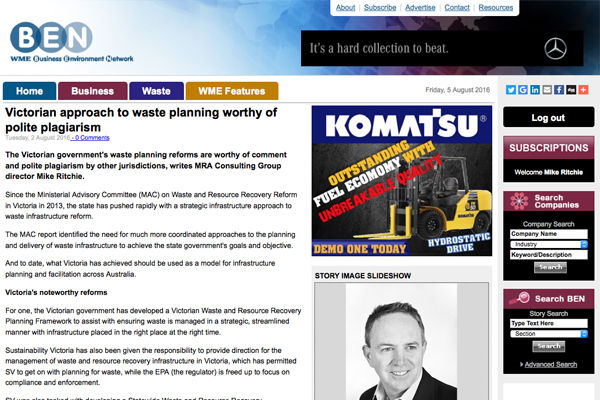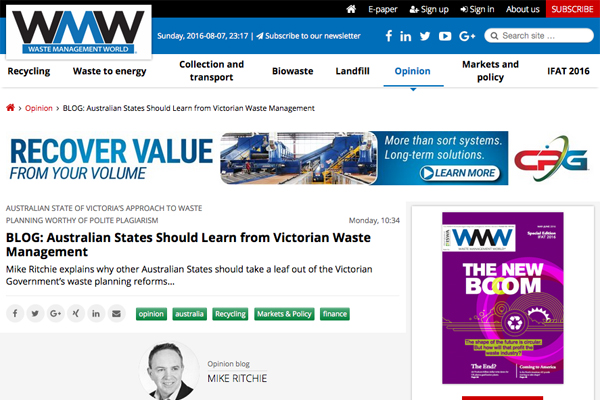Victorian approach to waste planning worthy of polite plagiarism
By Mike Ritchie – Managing Director, MRA Consulting Group
Since the Ministerial Advisory Committee on Waste and Resource Recovery Governance Reform in Victoria in 2013, Victoria has pushed ahead rapidly with a strategic infrastructure approach to waste infrastructure reform.
The Ministerial Advisory Committee report identified the need for much more coordinated approaches to the planning and delivery of waste infrastructure to achieve the State Government targets. The approach warrants description as a model for infrastructure planning and facilitation:
- Sustainability Victoria was given the overarching responsibility for waste planning in Victoria. That permitted Sustainability Victoria to get on with planning for waste, while the EPA (the regulator) was freed up to focus on compliance and enforcement.
- Sustainability Victoria was tasked with developing a State Waste Infrastructure Plan (SWIP), based on regional plans produced by reformed regional waste groups including the Metro Waste Management Group.
- Each Regional Waste Management Group was tasked with developing its regional infrastructure plan and to identify gaps in infrastructure provision. The plans included expected growth in generation, needs analysis and specifically identified infrastructure needs including organics processing, landfill void availability, MRF capacity, C&I sorting and hazardous waste collection, amongst many other components.
- The SWIP then integrated the regional plans to provide a State Plan. The State Plan also includes an approved landfill list. If a proposed landfill is not on the list it does not get built.
- In 2015 the Minister for Environment, Climate Change and Water, Lisa Neville released Victoria’s Waste and Resource Recovery Infrastructure Investment Prospectus which identified the key features of the State’s waste sector: growth, type, infrastructure needs and available high priority waste streams. The Prospectus was designed to encourage investment. It was a priority statement by Government on what it wants and on which waste streams.
- The key waste streams that Government seeks investment activity in include: e-waste, tyres, organics, timber, glass, plastics, textiles, paper and cardboard, mixed waste sorting, energy from waste and shredder floc.
- The Prospectus also pointed to the need for better Government coordination and particularly better integration of the State’s land use planning frameworks with waste and resource recovery planning.
Time will tell if this approach drives faster and more profitable investment in recycling infrastructure than previous ones. What is obvious though is that the emergence of plans for infrastructure, gap analyses, priority statements from government and reformed planning approvals are light years better than the ad hoc approaches that exist in many other jurisdictions.
As always, I welcome your feedback on this, or any other topic on ‘The Tipping Point’.
This article has been published by the following media outlets:





